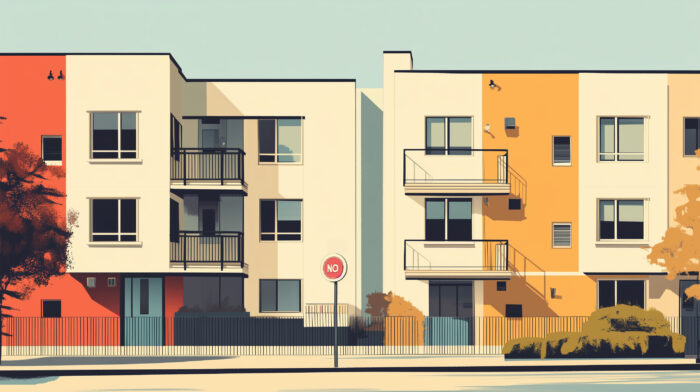If you have questions or want to learn more, please fill in the form or send us an email at:
Minimum Lot Size Model Legislation
Section 1
Purpose and Intent
- To expand affordable housing options and reduce development costs, this Act prohibits municipalities from imposing restrictive zoning requirements, including minimum lot sizes, excessive setbacks, and open space mandates, on properties served by municipal water and sewer systems. By removing these barriers, this Act promotes increased housing density and lowers entry costs for new housing development in designated areas, thereby supporting a more affordable, accessible housing market.
Section 2
Definitions
For purposes of this chapter:
- “Minimum Lot Size” means the smallest permissible area for a single parcel of land on which a building or structure may be constructed, as dictated by local or state zoning ordinances.
- “Municipality” means a political subdivision of a state, established by law as a city, town, village, or similar public entity, vested with certain governmental powers and duties to administer public policies, provide local services, and exercise regulatory authority within a designated geographical area, subject to the state’s constitution, statutes, and regulations.
- “Setback” means the minimum distance a structure must be positioned from the property boundaries (front, rear, and side). Setbacks allow space for public infrastructure, privacy, and emergency access, with this legislation capping setbacks at specified limits to promote efficient land use.
- “Lot Coverage” means the percentage of a lot’s total area that can be occupied by buildings and other impermeable structures. Lot coverage restrictions are intended to ensure some open or permeable space on each lot, and this legislation precludes municipalities from imposing lot coverage requirements that inhibit reasonable development.
- “Serviced Lot” refers to a legal parcel of land connected to both municipal water and sewer systems or has access to equivalent water and sewer infrastructure to ensure adequate service availability.
- “Unserviced Lots” means legal parcels or lots lacking water or sewer connections.
- “Housing Organization” means a trade or industry group whose local members are primarily engaged in the construction or management of housing units or a nonprofit organization whose mission includes providing or advocating for increased access to housing for low-income households and have filed written or oral comments with the local agency prior to action on the housing development project.
Section 3
Residential Lot Standards
- A municipality may not adopt or enforce an ordinance, rule, or other measure that requires minimum lot sizes exceeding 1,400 square feet for Serviced Lots designated for residential uses and connected to both municipal water and sewer systems.
- A municipality may not adopt or enforce an ordinance, rule, or other measure that requires Serviced Lots designated for residential use to be wider than 20 feet or deeper than 60 feet.
- If regulating residential density on a Serviced Lot, a municipality may not impose a dwelling unit density requirement that results in fewer than 32 units per acre.
Section 4
Preemption
- A municipality may not impose lot coverage requirements that prevent full utilization of the lot size permitted under this Act. This includes:
- Minimum square footage or dimension requirements for developments with fewer than four units.
- Maximum or minimum lot coverage requirements for developments with fewer than four units, as well as any accessory structures.
- A municipality may not enforce mandatory open space or green space requirements for structures with fewer than four units, except where necessary for stormwater management, flood control, or public safety.
- A municipality may not require minimum frontage requirements for individual parcels within a development.
- Any municipal zoning regulations that conflict with the provisions of this Act are preempted, nullifying local ordinances that impose larger lot sizes or additional restrictions contrary to this Act.
- A municipality may not impose design or lot coverage restrictions beyond basic health and safety standards, unless the property is located within a designated historic district or site.
- A municipality may not require the establishment of a Homeowners’ Association (HOA) solely to oversee common areas, amenities, or private streets as a condition for lot development approval, except where necessary for stormwater management.
- A municipality may:
- enforce standards that do not alter requirements for municipal sewer, water, or HOA deed restrictions, which may include architectural guidelines, communal maintenance standards, or land use conditions applicable to neighborhood plans;
- retain jurisdiction over essential infrastructure, including water, sewer, and stormwater management, to ensure safe, sustainable development;
- allow existing covenants, design standards, and historic district regulations to remain unaffected, provided they do not conflict with the lot size and setback flexibility afforded under this Act;
- enforce building codes, fire regulations, and health and safety standards to protect community welfare, including fire access, landslide prevention, and stormwater management; enforce lot coverage limits in areas prone to flooding, fire hazards, or other natural risks, to ensure compliance with broader public safety standards.
Section 5
Development Standards
- A municipality may not adopt or enforce building setback requirements that exceed the following limits:
- Front setback. Limited to a maximum of 10 feet from the property line
- Rear setback: Limited to a maximum of 4 feet from the property line;
- Side setbacks: Limited to a maximum of 3 feet from the property line.
- Municipalities must allow for a waiver of side setback requirements where the owners of both adjoining legal parcels request it.
- Municipalities may not require a setback between buildings in the same development, except as required by the Building Code.
- A municipality may impose height limits on developments, provided these limits are no more restrictive than the current height designation applicable to the Serviced Lot under the existing zoning.
Section 6
Architectural and Design Restrictions
- A municipality may not enforce design standards that conflict with the development standards and lot size requirements established under this Act.
- A municipality may not impose restrictions on architectural features or require mandatory design elements, except where the property is located within a designated historic district.
Section 7
Exemptions and Limitations
- Serviced Lots located within 1,600 feet of Title V industrial uses shall be ineligible under this act.
- Lots located in designated environmental protection zones, including wetlands, wildlife habitats, or areas subject to critical environmental regulations, are exempt from the provisions of this Act.
- The minimum setback and lot coverage requirements of this Act shall not apply to lots adjacent to critical infrastructure, such as highways, railroads, or major utility lines. Municipalities may enforce larger setbacks and additional restrictions to ensure public safety and infrastructure maintenance access.
Section 8
Enforcement
- A municipality that enacts or enforces any ordinance, rule, or regulation in violation of this Act shall be considered non-compliant. The municipality must repeal or amend any conflicting provisions within 30 business days of receiving a notice of non-compliance from:
- An affected property owner or developer.
- A person who would be eligible to apply for residency in the development or emergency shelter;
- or a Housing Organization, as defined, to bring an action to enforce its provisions.
- If a municipality fails to amend conflicting ordinances within the specified timeframe, any affected property owner or developer may seek relief in a court of competent jurisdiction. The court may issue an order directing the municipality to comply with the provisions of this Act, including the issuance of necessary permits or approvals.
- If a municipality delays permit approval or imposes additional requirements beyond those allowed under this Act, the property owner or developer shall be entitled to a refund of any associated permit fees, and the permit shall be deemed automatically approved after 30 business days.
- A municipality may not delay, deny, or obstruct the issuance of building permits or certificates of occupancy based on local ordinances that conflict with the provisions of this Act. Any such action shall be considered unlawful, and the property owner may file an appeal with the governing body of the political subdivision.
- Appeals must be filed within 15 business days of the denial or delay, and the governing body must render a decision within 30 business days. If no decision is reached, the permit application or inspection report shall be deemed approved.
- Municipalities shall not impose fines, fees, or penalties for non-compliance with local ordinances that are preempted by this Act. Any attempt to enforce conflicting regulations shall be null and void.
- In cases of continued non-compliance by a municipality, the state attorney general may intervene to enforce the provisions of this Act, including seeking injunctive relief or other legal remedies to ensure compliance with state law.
- Municipalities found in violation of this Act shall be subject to penalties, including:
- A fine equal to 30 percent of the final sale price of the land sold or developed in violation of this Act for a first violation.
- A fine equal to 50 percent of the final sale price for any subsequent violation.
- Municipalities found in violation of this Act shall be subject to penalties, including:
Section 9
Severability
- If any provision of this Act or its application to any person or circumstance is held invalid, the invalidity does not affect other provisions or applications of the Act that can be given effect without the invalid provision or application, and to this end, the provisions of this Act are severable. It is the intent of the legislature that this Act would have been enacted even if such invalid provision or application had not been included.
Section 10
Effective Date
- This act is ordered to take immediate effect.
Prohibiting Municipal Zoning Regulations to Encourage Housing Development
Reforming restrictive municipal zoning rules is key to creating more flexible land use and addressing the growing need for housing. Traditional zoning laws often impose minimum lot sizes, large setbacks, and open space requirements, which drive up development costs, limit land use efficiency, and reduce affordable housing availability. Updating these rules allows for more diverse housing options in both cities and suburbs.
Rigid lot size and setback requirements are outdated and limiting:
Many zoning codes require large lot sizes and wide setbacks, which don’t always match modern community needs or preferences. The National Association of Home Builders highlights that such requirements restrict land use efficiency, preventing higher-density housing development that could address growing demand. In densely populated areas with high housing demand, zoning regulations requiring large setbacks and expansive open spaces consume valuable land that could support additional housing units or community facilities. By relaxing these requirements, municipalities can construct more homes on the same land, boosting housing supply to meet demand and support community growth.
Restrictive zoning policies drive up housing costs:
Rules like minimum lot sizes and open space requirements make housing more expensive by limiting how many units can be built on a given property. Research from the Mercatus Center and Housing Affordability Institute shows how urban minimum lot sizes and setbacks contribute to higher housing prices and urban sprawl. This drives up land costs and reduces the supply of affordable homes for buyers and renters. Relaxing these restrictions allows for more housing to be built, helping to stabilize prices and expand affordability.
Unserviced areas remain unaffected:
This proposed zoning reform applies only to lots connected to municipal water and sewer systems, primarily in urban and suburban areas. Rural or unserviced lots would remain under traditional zoning standards, where larger lot sizes and extensive setbacks are typically more appropriate for low-density development. This ensures that zoning changes are context-sensitive and do not disrupt land-use practices in rural settings.
Zoning reform supports community growth and housing equity:
Municipalities can foster a more inclusive and affordable housing market by eliminating excessively restrictive zoning mandates. This approach supports a broader range of housing types suitable for various income levels and household sizes, helping to address housing inequality. Inclusive zoning allows for growth and diversity in housing options, contributing to community resilience and reducing barriers to affordable housing.
Examples of successful zoning reform:
Several jurisdictions have reformed zoning regulations to encourage more flexible land use, increase housing supply, and promote affordability. California’s SB 9 allows homeowners to split single-family lots and build up to four units, increasing housing density in residential neighborhoods. Similarly, SB 478 prevents excessive floor area ratio (FAR) and minimum lot size requirements, ensuring small-scale multifamily developments can proceed without restrictive zoning barriers. Examples of city-level reform include Spokane, Washington, setting a minimum lot size of 1,200 square feet, and Austin, Texas, lowering its lot size requirement from 5,750 square feet to 1,800 square feet (Mercatus Institute).


